The Grand Canyon has been a major tourist attraction in the US for more than a century. It was created as a result of geological activity and water erosion. We have gathered a complete set of Grand Canyon Facts for Kids that will give a complete overview of this amazing national park to the kids. We have tried to answer all questions that may arise in the curious little minds about this canyon. You are going to learn about why it is famous, the best months to visit, how dangerous is it, its geology, location, geography, history, tourism, flora and fauna, and many other interesting Grand Canyon Facts.
The Grand Canyon Facts
What Is The Grand Canyon – Grand Canyon Introduction
- The Grand Canyon is a steep-sided gorge or canyon located in Arizona, United States.
- A canyon means a deep cleft cut by weathering, geological activity, and erosion of a river.
- The Grand Canyon is about a mile deep, 277 miles long, and up to 18 miles wide.
- The Colorado River in Arizona carved it.
- It is one of the finest examples of arid-land erosion in the world.
- The Grand Canyon has been an official United States National Park since 1919.
What Is Grand Canyon Famous For – Why Is The Grand Canyon So Famous?
- The Grand Canyon is famous for its richest archeological history, numerous geologic features, and considerable fossil records.
- It is one of the world’s most studied landscapes.
- It is well-known for its finest and eye-catching sceneries.
What is the best month to visit the Grand Canyon?
- The best months to visit the Grand Canyon are from March to May and from September to November.
- During these months, the daytime is cool and there are no hordes of tourists.
- The summer season is the peak season of tourists. If someone decides to visit in summer, he would face huge crowds of tourists and limited lodging availability.
How dangerous is the Grand Canyon?
- The Grand Canyon is dangerous because of the hostile landscape and harsh weather.
- Visitors often underestimate the wilderness of the Canyon, which leads to life-threatening situations.
- The heat and extremely dry air of the desert quickly evaporate the sweat. So the hikers have a high risk of dehydration, heat exhaustion, and heatstroke. Since 2010, about 42 people have died of such conditions.
- Falling accidents are another danger at the Canyon. Visitors are advised to not climb fences and take extreme care near the edges. Since 2010, 27 people have died from fall accidents.
- The Grand Canyon National Park is considered the most dangerous National Park in the United States, where the number of total deaths since 2010 is 134.
What should you not do at the Grand Canyon?
- You should not do the following things at the Grand Canyon:
- Do not arrive at the peak season (Summer and Spring), otherwise, you would face a horde of visitors. Because millions of tourists visit the Grand Canyon each year.
- Do not neglect to bring enough water and stay hydrated. A hiker needs a gallon (4 liters) of water per day to feel best, as he/she is crossing a high desert.
- Do not underestimate the wilderness and altitude of the Canyon. When a visitor arrives at the South Rim, he/she has reached an elevation of 7,000 feet. While the altitude of the North Rim is 8,000 feet.
- Do not forget to pack for the changing weather conditions. Weather at the Canyon can suddenly change from warm to windy or raining or even snowing.
- Do not underestimate the sun and take sunscreen, hat, and lip balm, as the sun can be brutal suddenly.
- Do not get close to the Rim and do not climb fences. The mesmerizing views of the Canyon cause some people to lose track and forget where they are. So be careful, as one false step can take your precious life.
Why are there no fish in the Grand Canyon?
- A wide variety of fish was once found in the Colorado River, which is running through the Grand Canyon.
- However, the aquatic habitat of the Colorado River is variable and extremely challenging for fish. For example, the summer temperature is warm while the winter temperature is near-freezing, very large floods occur in the spring, and the silt load is heavy.
- As a result, most of the fish species did not endure the challenging habitat and disappeared. So, only eight fish species were native to the Canyon.
- These are:
-
- Humpback chub
- Razorback sucker
- Bluehead sucker
- Flannelmouth sucker
- Speckled dace
- Colorado pikeminnow (extirpated)
- Roundtail chub (extirpated)
- Bonytail (extirpated)
Did The Colorado River Create The Grand Canyon?
- Yes, the Colorado River created the Grand Canyon.
What Is The Geology Of The Grand Canyon – The Grand Canyon Geology
- The clear horizontal layers of different rocks in the Grand Canyon provide information about how, where, and when these rocks were deposited.
- As three main types of rocks can be also found in the Grand Canyon. These are:
-
- Igneous Rocks, which are cooled lava (molten rocks expelled through the ground) or magma (molten rocks found underground). Basalt and Granite are two types of igneous rocks. Basalt is formed from the cooling of the lava and is known as extrusive igneous rock. While granite is formed from the cooling of magma and is called intrusive igneous rock.
- Sedimentary rocks are formed by the accumulation of small pieces of mud and sand in layers.
- Metamorphic rocks are formed when igneous or sedimentary rocks are subjected to high temperature or pressure.
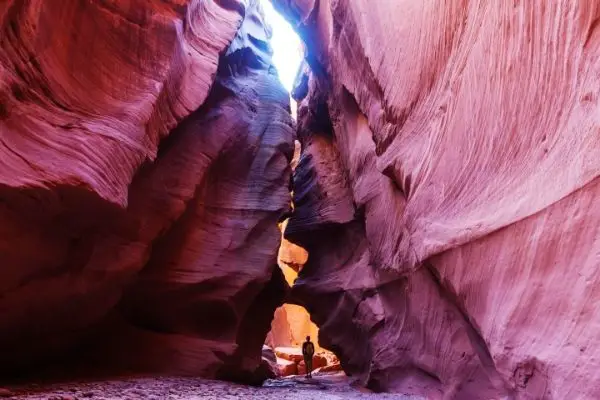
- There are three major sets of rock layers in the Grand Canyon that are grouped on the basis of their position and common composition. These are:
- Metamorphic Basement Rocks
-
- The oldest rocks in the Grand Canyon are mostly metamorphic with igneous intrusions (igneous intrusion means lava or magma cooled over previously formed rocks).
- These rocks are found at the bottom of the Canyon.
- Here, these rocks (the intrusive rocks) are known as Zoroaster granite.
- This set of rocks (a combination of the old igneous and metamorphic rocks found at this position) is named Vishnu Basement Rocks. These rocks are mostly schist (metamorphic) with granite (igneous) and have visible crystals.
- This set of rocks is about 1.7 billion years old and belongs to the Proterozoic era.
- Powell named this portion of exposed rock as “The Granite Gorge” during his expedition.
- The Precambrian Grand Canyon Supergroup
-
- The Precambrian Grand Canyon Supergroup is the middle set of rocks at the Grand Canyon.
- This is mostly composed of mudstone and sandstone, both are sedimentary type rocks with some igneous rock regions.
- This rock-set belongs to the late Proterozoic era and formed slightly late from the Metamorphic Basement Rocks.
- The rock layers in this portion have been tilted, while other rocks are horizontal above these rocks. This is called an angular unconformity.
- This then led to “The Great Unconformity” when the top part of these sediment layers eroded.
- The Paleozoic Strata
- This rock set is composed of sedimentary rocks that are primarily sandstones.
- The typical reddish layers of the Grand Canyon that we often see in the images are mostly made up of this rock set.
- This set lays above the Great Unconformity and has widespread fossils.
- This rock-set formed much later than the other rock layers of the Canyon.
- Scientist and explorer John Wasley Powell described the above sets of rocks for the first time during his expedition to the Canyon in the late 1860s and early 1870s.
Grand Canyon History Facts – What’s The History Of The Grand Canyon?
- The oldest rocks found at the bottom of the Canyon are estimated to be about 1.7 to 1.8 billion years old.
- Above these rocks is laying another ancient layer of sandstones, limestones, and shales that are estimated to be more than 540 million years old.
- Overlaying the top of this layer is another layer or set of rocks (the Paleozoic Strata) with the typical reddish color that we see in photos. The depositional period of this layer is estimated to be extending over 300 million years.
- The carving process of the mile-deep Grand Canyon through the Colorado River is relatively recent in the geologic history of the Canyon. It started around six million years ago when the river started flowing its present course.
- However, some recent studies reveal that the carving process may have started around 70 million years ago.
What Are The Oldest Rocks In The Grand Canyon?
- The oldest rocks in the Grand Canyon are the Vishnu Basement Rocks, which are estimated to be about 1.75 billion years old.
Grand Canyon Kid Activities
- There are many activities, in which kids can take part:
- They can participate in a Junior Ranger program
- They can learn about the geologic history of the Canyon
- They can learn about the ancient human history related to the Canyon
- They can ride a mule
- They can hike into the Canyon with adults
- They can experience the wonderful view of sunrise at the Canyon
Can You See The Grand Canyon From Space?
- Yes, you can see the Grand Canyon from space.
- Astronauts on the International Space Station often take photos of the Canyon.
How Big Is The Grand Canyon In Acres?
- The Grand Canyon is situated on 1.217 million acres.
How Deep Is Grand Canyon – Grand Canyon Depth?
- The Grand Canyon is 1,829 meters deep.
The Grand Canyon Size?
- The size of the Grand Canyon is 4,926 km².
- It is 446 km (277 miles) long, 29 km (18 miles) wide, and about 1.6 km (1 mile) deep.
Grand Canyon Size Comparison?
- In size, the Grand Canyon is bigger than the entire State of Rhode Island.
Is The Grand Canyon In Arizona?
- Yes, the Grand Canyon is in Arizona.
What Is Grand Canyon Known For?
- The Grand Canyon is known for:
- Richest archeological history
- Finest and eye-catching sceneries
- One of the Seven Natural Wonders of the world
Grand Canyon Village
- The Grand Canyon Village is located in Coconino County (Arizona), in the Grand Canyon National Park, at the South Rim of the Grand Canyon.
- It is a census-designated place with a population of 2,004 at the 2010 census.
- Its total area is 35 km², according to the United States Census Bureau.
- The village is focused to accommodate the tourists visiting the Grand Canyon.
Why Was The Grand Canyon Made A National Park?
- In 1893, president Benjamin Harison declared the Grand Canyon as a forest reserve and granted it federal protection.
- In 1903, President Theodore Roosevelt traveled to the Grand Canyon.
- President Roosevelt was a keen hunter and great lover of nature, so he wanted to keep the region pristine for future generations.
- He declared parts of the Grand Canyon as a federal game reserve. The region then became a National Monument in the upcoming years.
- In 1919, the Grand Canyon attained the status of the National Park.
What Is There To Do In Grand Canyon?
- The following are some of the best things to do in the Grand Canyon:
- Hiking in the Grand Canyon
- Riding a mule into the Canyon
- The train ride in the Grand Canyon
- Scenic drive near the Canyon
- A rafting trip in the Grand Canyon National Park
- Visiting and standing on the Grand Canyon Skywalk
- Desert jeep tour
- Helicopter tour over the Canyon
What Is The Weather In Grand Canyon – What Is The Grand Canyon Climate?
- In the Grand Canyon, weather changes according to altitude.
- The rims are forested and at enough elevation to receive snowfall. While in the Inner Gorge along the Colorado River, the climate is warm similar to those in Tucson and other low altitude desert locations in Arizona.
- The climate in the Grand Canyon is usually dry, however, considerable precipitation occurs twice in the year during the seasonal pattern shifts in late summer and winter.
- The South Rim receives the average annual precipitation of fewer than 16 inches with a typical snowfall of 60 inches.
- The North Rim, which is higher than the South Rim, receives the average annual precipitation of up to 27 inches with a snowfall of 144 inches.
- The Phantom Ranch, which is along the Colorado River and far below from the Rims, receives only 8 inches of average annual precipitation (that is rain, snow is very rare).
- Temperatures vary greatly throughout the year. Within the Inner Gorge, the temperature in the summer commonly exceeds 37.8 ℃ (100 ℉), while along the Canyon Rims, the temperature sometimes falls below – 17.8 ℃ (0 ℉).
- Air quality in the Grand Canyon region is some of the cleanest in the United States. However, events like dust storms in the Southwest and forest fires sometimes greatly affect the air quality.
Grand Canyon Skywalk
- The Grand Canyon Skywalk is a cantilever glass bridge located at the Grand Canyon West.
- It is a horseshoe-shaped bridge, which is 10 feet wide and extends 70 feet out over the rim.
Where Is Grand Canyon Skywalk?
- The location of the Grand Canyon Skywalk is not near the North or South Rims of the Grand Canyon National Park.
- Instead, it is built at the Grand Canyon West on reservation land owned by Hualapai Native American Tribe.
How Long Did It Take To Build The Grand Canyon Skywalk?
- The construction process of the skywalk was started on 6 October 2004 and took 18 months to complete.
- The welding of the 40-foot beams took an additional time of four months.
Death At Grand Canyon Skywalk
- On 30 September 2019, a man jumped from the Grand Canyon skywalk and did suicide in front of other visitors.
- Besides this, no other deaths occurred at the Grand Canyon Skywalk.
Facts About The Grand Canyon Skywalk
- The Grand Canyon Skywalk is located in northern Arizona in the Grand Canyon West region of the main canyon.
- It is owned by the Hualapai Native American Tribe.
- It is made up of steel and glass and cantilevers 70 feet out over the edge of the Grand Canyon.
- According to the topographic maps of the United States Geological Survey, the altitude at the location of the skywalk is 4,470 feet (1,450 meters). While the altitude of the Colorado River in the Canyon’s base is estimated as 1,160 feet (350 meters).
- 90 tons of strengthened glass was used in the construction of the walkway, which was imported from Germany.
- The skywalk is hanging around 4,000 feet above the floor of the Colorado River Valley.
- According to the engineers, the peach-color frame of the skywalk is strong enough to hold the weight of 70 “Boeing 747” passenger jets.
What Is Special About The Grand Canyon?
- The Grand Canyon is one of the Seven Natural Wonders in the world.
- It is one of the world’s finest examples of arid-land erosion.
- The layered bands of the rocks in the Canyon reveal millions of years of archeological history.
Grand Canyon Tourism Facts
- The Grand Canyon is one of the leading natural attractions in the world.
- More than 5 million tourists visit the Grand Canyon National Park each year.
- About more than 80% of the overall tourists are usually from the United States, while more than 17% are from outside of the United States.
- If the weather is good enough to allow, the South Rim is open for tourists throughout the year.
- The North Rim is usually open for tourists from mid-May to mid-October.
How Big Is Grand Canyon National Park?
- The area of the Grand Canyon National Park is 4,924 km².
- In acres, it is 1,218,375 acres.
How Many Tourists Visit Grand Canyon Each Year?
- More than 5 million tourists visit the Grand Canyon each year.
Is Grand Canyon A National Park?
- Yes, the Grand Canyon is a National Park.
Why Is The Grand Canyon Important To History?
- The Grand Canyon is important to history because it contains some of the oldest rocks on the Earth.
- The thick layers of the ancient rocks reveal about 2 billion years of the Earth’s geologic history.
Activities In Grand Canyon – Grand Canyon Activities
- Major activities in the Grand Canyon include:
- Hiking tours
- Helicopter tour over the Canyon
- Riding a mule into the Canyon
- Rafting trip in the Grand Canyon National Park
- Scenic drive near the Canyon
- Night camping
Does The Colorado River Go Through The Grand Canyon?
- Yes, the Colorado River goes through the Grand Canyon.
What Animals And Plants Live In The Grand Canyon – Grand Canyon Flora And Fauna
Animals
- Animal species are abundantly found in the Grand Canyon region.
- 90 mammal species are found in the region, including squirrels, coyotes, bobcats, badgers, foxes, deer, rabbits, kangaroo rats, and chipmunks.
- Many bird species are also found in the region, including raptors (bald eagle, peregrine falcon, and the rare California condor).
- Six species of rattlesnakes are found in the region, of which, the pink rattlesnake is native to the Canyon.
- Fish species in the region include trout (found in the Little Colorado River) and the rare humpback chub.
Plants
- A wide variety of plant life is found in the region. In the Grand Canyon National Park, there are about 1,737 known species of vascular plants, 64 moss species, 195 lichen species, and 167 species of fungi.
- In the bottom portion of the Canyon, cottonwoods and willows are found that need abundant water for growing.
- Drought-resistant plant species include yuccas, agaves, tamarisks, and many species of cactus.
- A wide variety of plant species are also found on the North and South Rims of the canyon.
- There is a well-developed ponderosa pine forest on the South Rim, which receives about 380 mm annual precipitation. Bush vegetations are mainly large sagebrush, scrub oak, and mountain mahogany.
- There are impressive forest communities of ponderosa pine, blue spruce, white and Douglas fir, and aspen on the North Rim, which receives annual precipitation of 660 mm.
Geography Of Grand Canyon
- The Grand Canyon exists on the Colorado Plateau and occupies a large region of the southwestern United States.
- Between its outer walls, the wide intricately sculptured deep fissure of the Canyon contains a large number of striking peaks, buttes, ravines, and gorges.
- In width, it ranges from about 160 meters to 29 km and extends in a curved course from the mouth of the Paria River (near Lees Ferry) to Grand Wash Cliffs.
- The Canyon from Lees Ferry to the conflux with the Little Colorado River is known as the Marble Canyon.
- The surrounding plateaus and many other tributary side canyons are also included in the Grand Canyon.
Grand Canyon History And Culture
- The first evidence of the human presence in the Grand Canyon region dates back to about 10,500 years.
- Native Americans have been living in the Grand Canyon and the surrounding regions for at least 4,000 years.
- Ancestral Pueblo people (ancient Native American culture, initially as the Basketmaker culture and then later as the well-known Pueblo people) developed from the Desert Culture as they began to be less nomadic and more reliant on agriculture.
- Cinchona was a similar culture that also lived in the Canyon region.
- In the late 13th century, a drought probably caused both groups to leave the region.
- Captain Garcia Lopez de Cardenas was a Spanish conquistador and explorer. In September 1540, he was directed by the conquistador Francisco Vasquez de Coronado to find the legendary Seven Cities of Gold. He led a party of Spanish soldiers to the Grand Canyon under the guidance of Hopi guides. He became the first European and non-Native American person to see the Grand Canyon.
Why Is It Called Grand Canyon?
- John Wesley Powell used the term “Grand Canyon” for the first time in 1871. He steered wooden boats along with his nine companions for up to 1,000 miles on the Colorado River in 1869. During this expedition, they also went through the Canyon.
- Before Powell, fur trappers of Taos (native Americans from New Mexico) knew about the gorge and they called it the Big Canon.
Do Animals Live In The Grand Canyon?
- Yes, a wide variety of animal species live in the Grand Canyon and the surrounding area.
- Around 90 species of mammals are found in the region, while other animals include birds, snakes (rattlesnakes), fish, and invertebrates.
How Were The Grand Canyons Formed?
- The Grand Canyon was formed when the Colorado River started to cut a channel through the rock layers about 5 to 6 million years ago.
- Since that time, the Colorado River has operated the down-cutting process of the tributaries and pull back of the cliffs. It causes a simultaneous widening and deepening of the Canyon.
In Which State Is The Grand Canyon Located?
- The Grand Canyon is located in Arizona State.
Where Is The Grand Canyons Located – Grand Canyon Location?
- The Grand Canyon is located in the northwest corner of Arizona State.
- It is near the borders of the Utah and Nevada States.
The Grand Canyon Fun Facts – Fun Facts About Grand Canyon
- The Grand Canyon is one of the few natural landmarks on the Earth that are visible from space.
- Contrary to common belief, the Grand Canyon is not the world’s deepest canyon. The Barranca del Cobre (Copper Canyon) in northern Mexico and Hell’s Canyon in Idaho (United States) are both deeper than the Grand Canyon.
- The Grand Canyon is bigger in size than the State of Rhode Island.
- The Grand Canyon Skywalk is the highest human-made structure in the world.
- The animal species that most often bite visitors in the Grand Canyon is not the Gila monster or pink rattlesnake, but the rock squirrel.
The Grand Canyon Interesting Facts – Interesting Facts About Grand Canyon – What Are Some Interesting Facts About The Grand Canyon – Facts About The Grand Canyon
- The Grand Canyon is one of the seven natural wonders of the world.
- It is one of the most visited National Parks in the USA that welcomes more than 5 million visitors each year.
- The oldest rocks in the Grand Canyon are estimated to be about 1.7 to 1.8 billion years old.
- Garcia Lopez de Cardenas (from Spain) was the first European known to have viewed the Grand Canyon in 1540.
- The widest point of the Canyon is 29 km (18 miles) vast, while its narrowest point is 6.4 km (4 miles) vast.
- It is considered that the Colorado River started the carving of the Grand Canyon around 6 million years ago. However, recent studies show that the carving process may have started around 70 million years ago.
- Air quality in the Grand Canyon region is considered as some of the cleanest in the United States.
- In the walls of the Grand Canyon, many split-twig figurines have been discovered that are shaped like bighorn sheep and deer.
- A large number of hidden caves exist in the Canyon. Currently, only one of these caves, the Cave of the Domes on Horseshoe Mesa, is open to the public.
- The Grand Canyon has a great spiritual significance for the Hopi Tribe of the Native Americans. For them, the site is a gateway to the afterlife.

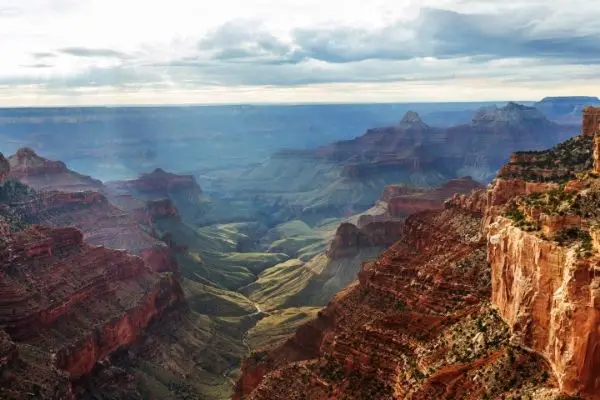
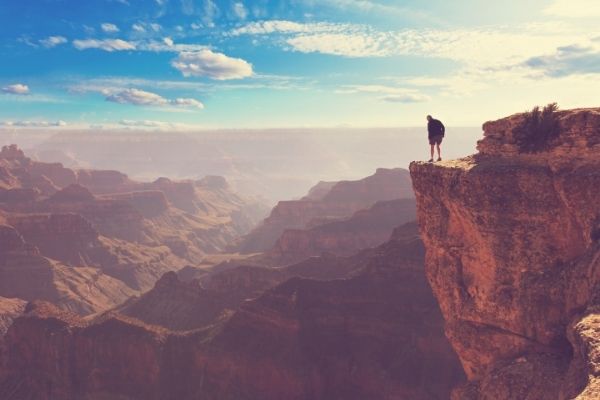


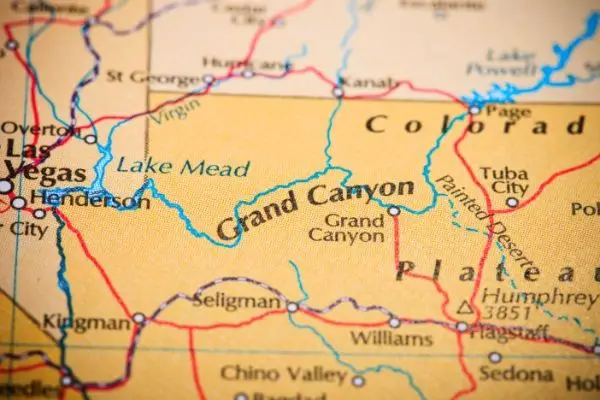



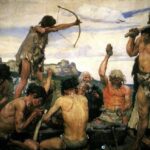



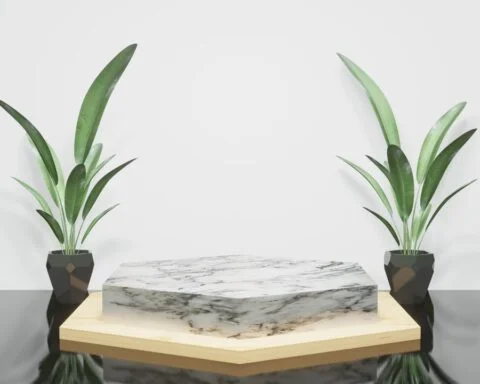

Can I have a free book please.